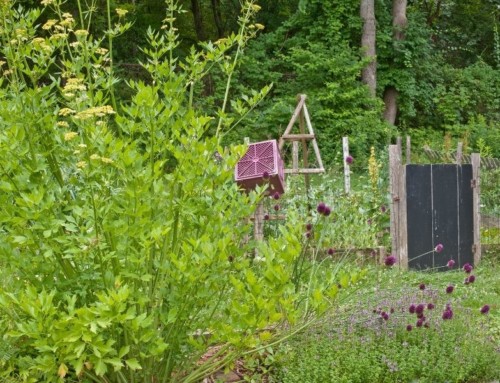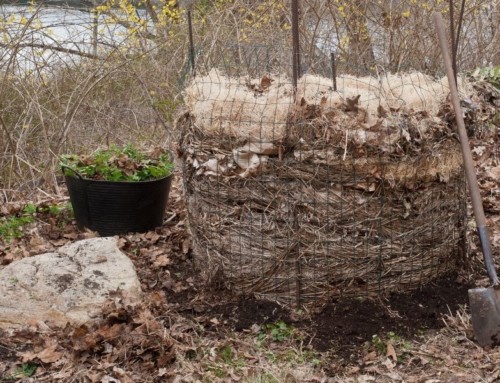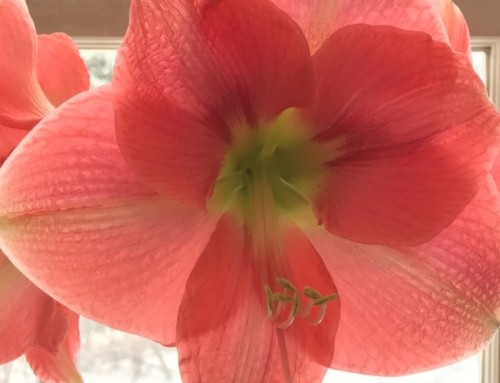Life is too short to fuss with staking perennials to keep them upright and looking good.
Late-blooming top-heavy floppers are lurking in the garden. They look perfectly innocent in June and early July, but get gangly and fall over when they bloom in September and October. Trying to fix them with finesse after the fact is an exercise in frustration.
It’s easy to control the eventual height of many perennials if you cut them back early. Cutting back – by a third to a half, even two-thirds – stimulates branching, so plants grow fuller, sturdier and shorter.
More branching stems means more flowers, but they will bloom a couple weeks later than normal. If you cut some stems and leave some alone, you – and the pollinators in your yard – will enjoy an extended season of bloom.
Follow this link to Nancy Teaches Perennial Pruning for a demonstration by Nancy DuBrule-Clemente of Natureworks, an organic garden center in Northford, CT.
Timing is important. My Monarda didyma ‘Raspberry Wine’ is beginning to flower and Joe-Pye weed is budded up. I’m not hardhearted enough to cut them back now. Should have done them, and the butterfly weed, also blooming now, in early June.
There’s still time for some fall bloomers, so don’t wait – get out your clippers.
This technique works really well with New England asters (Symphotrichum novae-angliae). I’m happy to see seedlings in the sunny front garden, but one-stem wonders falling every which way don’t thrill me.
Throughout June I cut back my asters at different times and at different heights, to blend in with surrounding plants and extend season of bloom.
Some I’ll cut back again in coming days so they branch lower. With global warming I’m not worried about a hard freeze hitting before they bloom.
New England asters get a bad rap for having ugly legs. Lower leaves die before plants bloom because asters evolved with grasses and other plants shading their nether regions. No need to put energy into growing leaves that can’t photosynthesize.
You could buy a clonal cultivar that has shorter, easier to hide legs, but may or may not provide ample floral resources for pollinators.
Why not plant the genetically diverse straight species pollinators love and just cut them back to bloom at whatever height suits you?
On up-close plants I like to cut back individual stems to an outward-facing leaf, trying to minimize ugly stubs. Further back or if I’m in a hurry I just grab a bunch of stems in one hand and clip away.
My friend Dana demonstrates in my front garden in the photo at the top of the page. The photo below shows stems shortened by third to a half.
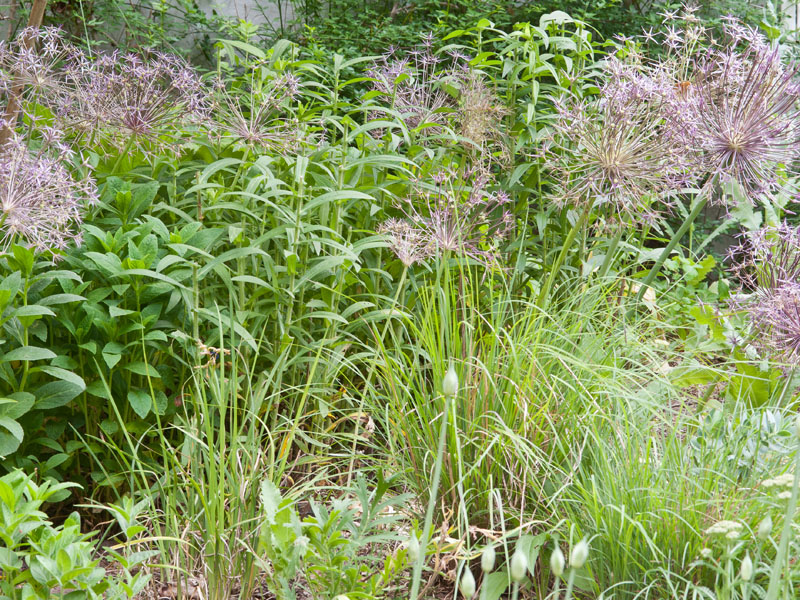
Aster stems cut back by a third to a half
Reducing the height of New England asters in my sunny front garden gave Allium christophii and great blue lobelia (Lobelia siphilitica) their day in the sun. I might cut some front stems back even shorter to stagger bloom and conceal taller stems.
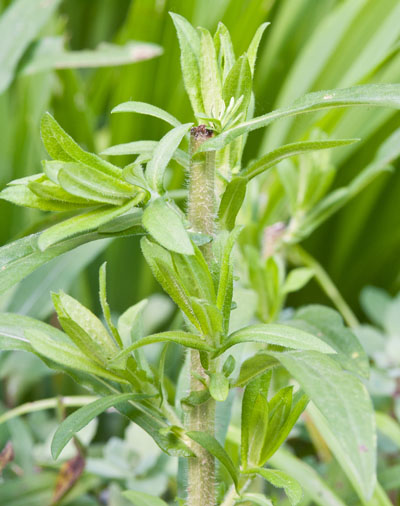
Cutting back aster stems quickly stimulates new branching
Deer always munch my Rudbeckia triloba in early summer, leaving nasty-looking bare stems sticking up. I trim them back to an outward-facing leaf if I get around to it. Whether I do or not, these brown-eyed Susans still bush out and bloom bigtime in late summer throughout the fall. July isn’t too late to cut them back for a big show later on.
Some years ago I planted what was supposed to be a dwarf aromatic aster (Symphotrichum oblongifolium ‘October Skies’), supposedly about 18″ tall. It must be the straight species because it’s 40″ tall already and always splits open if I don’t cut it’s height in half. It is about to get a 4th of July haircut.
I wouldn’t hesitate to cut back my very late-blooming mums, anise hyssop, Boltonia asteroides ‘Snowbank’, or tall late heleniums either.
Last year, the lusty native blue mist flower (Conoclinum coelestinum, formerly Eupatorium coelestinum) I transplanted to my new rain garden took off a lot faster than common rush (Juncus effusus) plugs. They’ll get a July 4 shearing too, to even the playing field. By next year the rushes will be tall enough to fend for themselves.
The definitive guide to this kind of strategic cutting back is Tracy DiSabato-Aust’s The Well-Tended Perennial Garden: Planting and Pruning Techniques. Every time I look something up in my 1998 edition I learn more efficient ways to keep the garden looking good. There’s a newer edition and ebook version.
While I was boning up on the technique, I came across another timely tip. Now that moss phlox (Phlox subulata) has finished blooming, it should be cut in half with hedge shears to prevent plants from opening up in the center later on.
One more ‘to-do” for an early July day in the garden.


